Kia Optima 2007 Owner's Manual

GAS STATION INFORMATION
)l )l
)l )l
Gasoline
UNLEADED gasoline
AKI (Anti-Knock Index) 87 or higher
Fuel Tank Capacity
16.4 gal. (62 liters)
Recommended Engine Oil
API service SJ, SL or above ILSAC GF-3 or above
Engine Oil Capacity with Filter
2.4L Engine : 4.5 US qt. (4.3
2.7L Engine : 4.7 US qt. (4.5
Engine Coolant
2.4L Engine : 6.8~7.3 US qt. (6.4~6.9 l)
2.7L Engine : 8.7~8.8 US qt. (8.2~8.3 l)
Tire Pressure (measured cold)
P205/60R16 : 30 psi P215/50R17 : 32 psi
Compact SpareTire Pressure
T125/80D16 : 60 psi
Automatic Transaxle Fluid
Diamond ATF SP-III, SK ATF SP-III or other brands meeting the SP-III specification approved by Kia Motors Corp. 2.4L Engine : 8.2 US qt. (7.8
2.7L Engine : 10 US qt. (9.5
Brake Fluid
FMVSS116 DOT-3 or DOT-4
Power Steering Fluid
PSF-IV

kia, the company
Congratulations! Your selection of a Kia was a wise investment. It will give you years of driving pleasure. Now that you are the owner of a Kia vehicle, you’ll probably be asked a lot of questions about your vehicle and the company like “What is a Kia?”, “Who is Kia?”, “What does ‘Kia’ mean?”.
Here are some answers. First, Kia is the oldest car company in Korea. It is a company that has thousands of employees focused on building high-quality vehicles at affordable prices.
The first syllable,inKithe word “Kia” means “to arise from to the world” or “to come up out of to the world.” The second syllable,, a means “Asia.” So, the word,meansKia “to arise from” or “to come
up out of Asia to the world.”
Drive safely and enjoy your Kia! 

Foreword
Thank you for choosing a Kia vehicle.
When you require service, remember that your dealer knows your vehicle best. Your dealer has factory-trained technicians, recommended special tools, genuine Kia replacement parts and is dedicated to your complete satisfaction.
Because subsequent owners require this important information as well, this publication should remain with the vehicle if it is sold.
This manual will familiarize you with operational, maintenance and safety information about your new vehicle. It is supplemented by a Warranty and Consumer Information manual that provides important information on all warranties regarding your vehicle.
We urge you to read these publications carefully and follow the recommendations to help assure enjoyable and safe operation of your new vehicle.
Kia offers a great variety of options, components and features for its various models.
Therefore, the equipment described in this manual, along with the various illustrations, may not all be applicable to your particular vehicle.
The information and specifications provided in this manual were accurate at the time of printing. Kia reserves the right to discontinue or change specifications or design at any time without notice and without incurring any obligation. If you have questions, always check with your Kia Dealer.
We assure you of our continuing interest in your motoring pleasure and satisfaction in your Kia vehicle.
© 2007 Kia Motors America, Inc.
All rights reserved. May not be reproduced or translated in whole or in part without the written consent of Kia Motors America, Inc.
Printed in Korea
i

|
|
|
|
|
|
|
|
|
|
|
Introduction |
|
1 |
|
|
|
|
|
|
|
|
|
|
|
Your vehicle at a glance |
|
2 |
|
|
|
|
|
|
|
|
|
|
|
Knowing your vehicle |
|
3 |
|
|
|
|
|
|
|
|
|
|
|
Driving your vehicle |
|
4 |
|
|
|
|
|
|
|
|
table of contents |
|
|
Driving tips |
|
5 |
|
|
|
|
|
|
|
|
|
|
||||
|
|
|
|
In case of an emergency |
|
6 |
|
|
|
|
|
|
|
|
|
|
|
Maintenance |
|
7 |
|
|
|
|
|
|
|
|
|
|
|
Specifications |
|
8 |
|
|
|
|
|
|
|
|
|
|
|
Consumer assistance (U.S. only) |
|
9 |
|
|
|
|
|
|
|
|
|
|
|
Index |
|
10 |
|
|
|
|
|
|
|
|
|
|
|
|
|
|
|
|
|
|
|
|
|
ii

Introduction |
|
1 |
How to use this manual / 1-2
Vehicle break-in process / 1-2
Vehicle data collection and event data recorders / 1-3

Introduction
HOW TO USE THIS MANUAL
We want to help you get the greatest possible driving pleasure from your vehicle. Your Owner’s Manual can assist you in many ways. We strongly recommend that you read the entire manual. Especially, in order to minimize the chance of death or injury, you must read the WARNING and CAUTION sections spread throughout the manual.
Illustrations complement the words in this manual to best explain how to enjoy your vehicle. By reading your manual, you learn about features, important safety information, and driving tips under various road conditions.
The general layout of the manual is provided in the Table of Contents. A good place to start is the index; it has an alphabetical listing of all information in your manual.
Sections: This manual has nine sections plus an index. Each section begins with a brief list of contents so you can tell at a glance if that section has the information you want.
You’ll find various WARNING’s, CAUTION’s, and NOTICE’s in this manual. These were prepared to enhance your personal safety.You should carefully read and follow ALL procedures and recommendations provided in these WARNING’s, CAUTION’s and NOTICE’s.
 WARNING
WARNING
A WARNING indicates a situation in which serious bodily injury or death could result if the warning is ignored.
 CAUTION
CAUTION
A CAUTION indicates a situation in which personal injury, perhaps severe, could result if the caution is ignored.
NOTICE
A NOTICE indicates a situation in which damage to your vehicle could result if the notice is ignored.
VEHICLE BREAK-IN PROCESS
No special break-in period is needed. By following a few simple precautions for the first 600 miles (1,000 km) you may add to the performance, economy and life of your vehicle.
•Do not race the engine.
•Do not maintain a single speed for long periods of time, either fast or slow. Varying engine speed is needed to properly break-in the engine.
•Avoid hard stops, except in emergencies, to allow the brakes to seat properly.
•Avoid full-throttle starts.
 PROPOSITION 65 WARNING
PROPOSITION 65 WARNING
Engine exhaust and a wide variety of automobile components and parts, including components found in the interior furnishings in a vehicle, contain or emit chemicals known to the State of California to cause cancer and birth defects and reproductive harm. In addition, certain fluids contained in vehicles and certain products of component wear contain or emit chemicals known to the State of California to cause cancer and birth defects or other reproductive harm.
1 2

VEHICLE DATA COLLECTION AND EVENT DATA RECORDERS
Your Kia vehicle is equipped with many high technology, electronically controlled systems that help to ensure your vehicle operates properly and provides the performance that you expect. These systems utilize computers to monitor the operation of various systems and components and help to control their operation. These computerized system operations are wide-ranging and involve components to reduce emissions, to continuously evaluate the readiness of the airbag and seatbelt pretensioner systems, to determine when the airbag and seatbelt pretensioner systems should be deployed and then to activate the deployment, and if equipped, to operate anti-lock braking, traction control and electrical stability control to assist the driver to control the vehicle in difficult driving situations. These systems electronically store information that is useful to service technicians when they need to diagnose and repair these systems.
Additional information is stored only when a crash occurs that results in the deployment of the airbags or seatbelt pretensioners. This type of data storage is done by devices called event data recorders (EDR).
After a crash event, the airbag and seatbelt pretensioner computer system, known as the Supplemental Restraint System Control Module (SRSCM) or Airbag Control Unit (ACU), may record some information about the condition of the vehicle and how it was being operated. This information consists of data related to seatbelt usage and if there was diagnostic information in the airbag or seatbelt systems at the time that a crash occurred, and if the ACU sensed that a crash of sufficient severity occurred to require seat belt pretensioner or airbag deployment.
Introduction
To retrieve this information, special equipment is needed and access to the vehicle or the device that stores the data is required. Kia will not access information about a crash event or share it with others except:
•in response to an official request of police or similar government office, or
•with the consent of the vehicle owner or, if the vehicle is leased, with the consent of the lessee, or
•as part Kia’s defense of litigation through the discovery process, or
•as required by law.
Your rights with respect to the information discussed above may vary from state to state. In some states, such information is considered private, is exclusively owned by the owner of the motor vehicle, and is not retrievable or usable by another person or entity.
1 3

Your vehicle at a glance |
|
2 |
|
|
|
Interior overview / 2-2
Instrument panel overview / 2-3
Engine compartment / 2-4
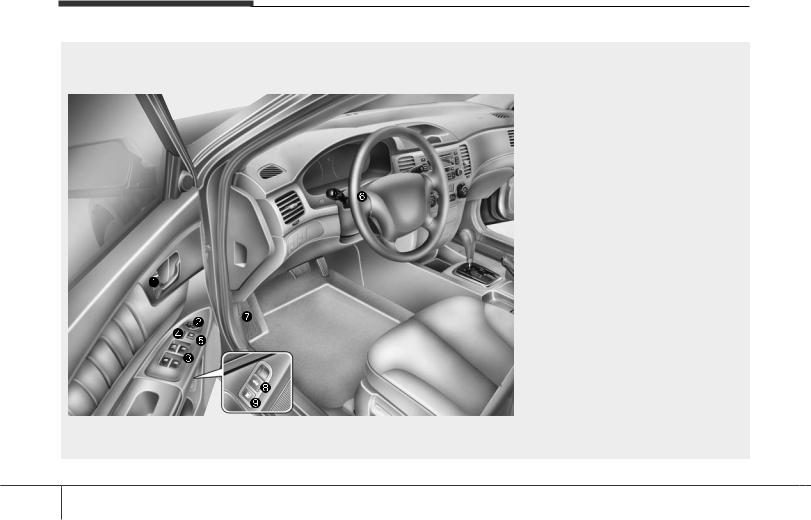
Your vehicle at a glance
INTERIOR OVERVIEW
1. |
Door lock/unlock button..................... |
3-10 |
2. |
Outside rearview mirror control |
|
|
switch*............................................... |
3-74 |
3. Power window switches* ................... |
3-13 |
|
4. |
Master power door lock control* ....... |
3-11 |
5. |
Master power window control lock*... |
3-16 |
6. |
Steering wheel .................................. |
4-16 |
7. |
Hood release lever ........................... |
3-70 |
8. Trunk release lever* .......................... |
3-69 |
|
9. |
Fuel filler lid release button............... |
3-71 |
* : if equipped |
|
|
OMG025001
2 2

Your vehicle at a glance
INSTRUMENT PANEL OVERVIEW
1. |
Driver’s Air Bag ................................. |
3-50 |
|
2. |
Light control / Turn signals ................ |
4-42 |
|
3. |
Instrument cluster ............................. |
4-24 |
|
4. Wiper/Washer.................................... |
4-46 |
||
5. |
Ignition switch.................................... |
4- 2 |
|
6. |
Digital clock....................................... |
3-93 |
|
7. Hazard............................................... |
4-48 |
||
8. Rear window defroster ...................... |
4-48 |
||
9. |
Climate control system ............. |
4-49/4-56 |
|
10. |
Shift lever.................................... |
4-4/4-6 |
|
11. |
Cigar lighter..................................... |
3-90 |
|
12. |
Front passenger’s air bag ............... |
3-51 |
|
13. Glove box ........................................ |
3-89 |
||
14. Seat................................................. |
3-17 |
||
15. |
Audio controls*................................ |
3-99 |
|
* : if equipped
OMG025002
2 3
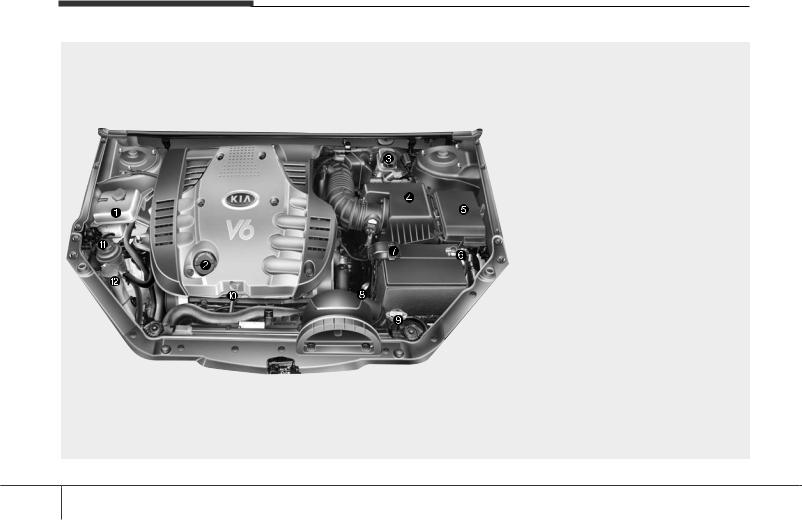
Your vehicle at a glance
ENGINE COMPARTMENT
1. |
Engine coolant reservoir ................... |
7-14 |
2. |
Engine oil filler cap............................ |
7-13 |
3. |
Brake fluid reservoir .......................... |
7-16 |
4. |
Air cleaner......................................... |
7-20 |
5. Fuse box ........................................... |
6- 8 |
|
6. |
Negative battery terminal ........... |
6-4/7-24 |
7. |
Positive battery terminal ............. |
6-4/7-24 |
8. |
Auto transaxle oil dipstick* ................ |
7-18 |
9. |
Radiator cap...................................... |
7-15 |
10. Engine oil dipstick ........................... |
7-13 |
|
11. Power steering fluid reservoir ......... |
7-17 |
|
12. Windshield washer fluid reservoir ...7-19 * : if equipped
OMG075002
2 4

Keys / 3-2
Remote keyless entry / 3-4
Theft-alarm system / 3-6
Immobilizer system / 3-8
Door locks / 3-9
Window / 3-13
Knowing your vehicle |
|
3 |
|
|
|
Seat / 3-17
Safety belts / 3-27
Air bags-advanced supplemental restraint system / 3-47
Trunk / 3-68
Hood / 3-70
Fuel filler lid / 3-71
Mirrors / 3-74
HOMELINK® Wireless Control System / 3-79
Interior lights / 3-87
Storage compartment / 3-88
Interior features / 3-90
Sunroof / 3-94
Luggage net / 3-96
Antenna / 3-97
Audio remote control / 3-98
Audio system / 3-99
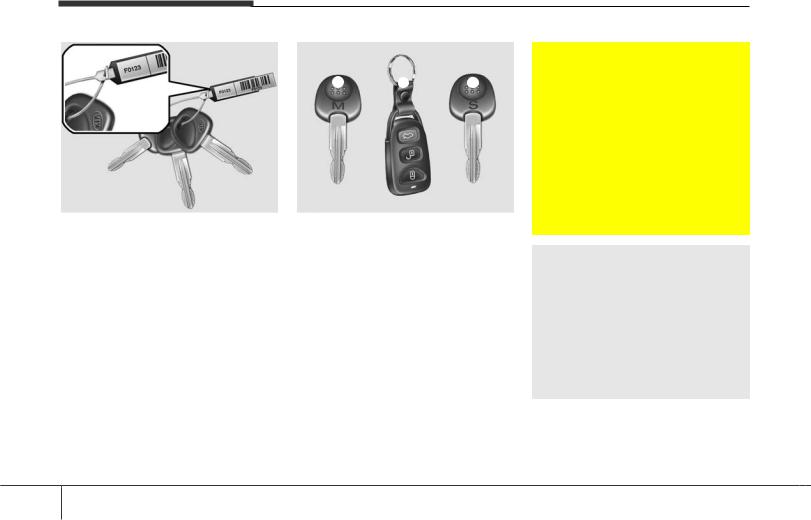
Knowing your vehicle
KEYS
OMG035108
The key code number is stamped on the plate attached to the key set. Should you lose your keys, this number will enable an authorized Kia dealer to duplicate the keys easily. Remove the plate and store it in a safe place. Also, record the code number and keep it in a safe and handy place, but not in the vehicle. Use only Kia-approved key blanks.
1 |
2 |
3 |
OMG035109
Key operations
(1)Master key
Used to start the engine, lock and unlock the doors, lock and unlock the glove box (if equipped), and open the trunk.
(2)Transmitter (if equipped)
Used to lock and unlock the doors and trunk.
(3)Sub key (if equipped)
Used only to start the engine and lock and unlock the door.
 WARNING - Ignition key
WARNING - Ignition key
Leaving children unattended in a vehicle with the ignition key is dangerous even if the key is not in the ignition. Children copy adults and they could place the key in the ignition. The ignition key would enable children to operate power windows or other controls, or even make the vehicle move, which could result in serious bodily injury or even death. Never leave the keys in your vehicle with unsupervised children.
 CAUTION
CAUTION
Use only Kia original parts for the ignition key in your vehicle. If an aftermarket key is used, the ignition switch may not return to ON after START. If this happens, the starter will continue to operate causing damage to the starter motor and possible fire due to excessive current in the wiring.
3 2

Knowing your vehicle
OMG035003
Restrictions in handling keys
When leaving keys with parking lot and valet attendants, the following procedures will ensure that your vehicle’s trunk and glove box compartment can not be opened in your absence.
With master and sub key (if equipped)
1.Open the trunk with the master key.
2.Set the trunk lid lock knob in the trunk
to LOCK (  ) position. In the LOCK (
) position. In the LOCK ( ) position, the trunk can not be unlocked with either the trunk release lever inside the car or trunk open button of the transmitter.
) position, the trunk can not be unlocked with either the trunk release lever inside the car or trunk open button of the transmitter.
3.Close the glove box, and lock the glove box using the master key.
4.Leave the attendant with the sub key. The trunk and glove box are secured because the sub key only allows engine start and door lock and unlock.
3 3
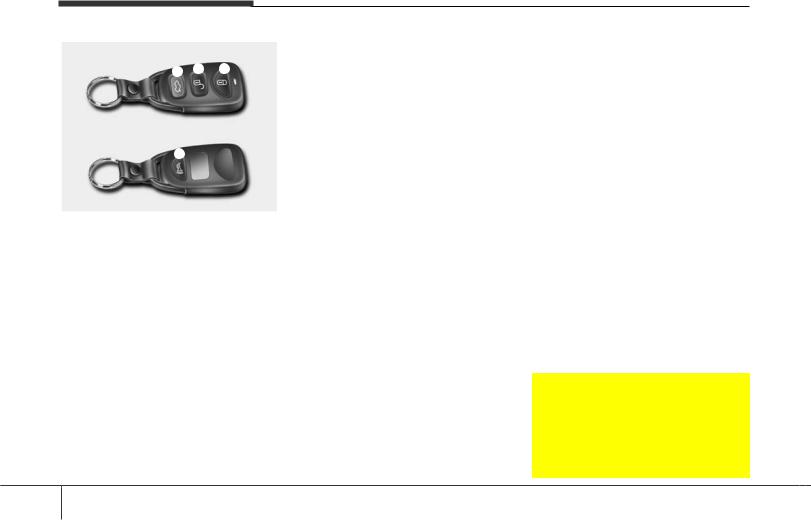
Knowing your vehicle
REMOTE KEYLESS ENTRY (IF EQUIPPED)
3 2 1
4
OMG035004
(1)Lock button
(2)Unlock button
(3)Trunk lid open button
(4)Alarm button
(1)Lock (  )
)
All doors are locked and hazard warning lights flash once if the lock button is pressed.
(2)Unlock ( )
)
Driver’s door is unlocked and hazard warning lights flash twice if the unlock button is pressed once. All doors are unlocked if the unlock button is pressed twice within 4 seconds.
After pressing this button, the doors will be locked automatically unless you open them within 30 seconds.
(3)Trunk lid open (  , if equipped)
, if equipped)
The trunk lid opens if this button is pressed (more than 1 second).
(4)Alarm ( 
 )
)
The horn sounds and hazard warning lights will flash for about 30 seconds if this button is pressed (more than 0.5 second). To stop the horn and lights, press any button on the transmitter.
NOTICE
The transmitter will not work if any of following occur:
•The ignition key is in ignition switch.
•You exceed the operating distance limit (about 30 feet [10 m]).
•The battery in the transmitter is weak.
•Other vehicles or objects may be blocking the signal.
•The weather is extremely cold.
•The transmitter is close to a radio transmitter such as a radio station or an airport which can interfere with normal operation of the transmitter.
When the transmitter does not work correctly, open and close the door with the ignition key. If you have a problem with the transmitter, contact an authorized Kia Dealer.
NOTICE
Keep the transmitter away from water or any liquid. If the keyless entry system is inoperative due to exposure to water or liquids, it will not be covered by your manufacturer vehicle warranty.
Operational distance may vary depending upon the area the transmitter is used in. For example, if the vehicle is parked near police stations, government and public offices, broadcasting stations, military installations, airports, or transmitting towers, etc., these may interfere with the signal.
This device complies with Part 15 of the FCC rules. Operation is subject to the following two conditions:
1.This device may not cause harmful interference, and
2.This device must accept any interference received, including interference that may cause undesired operation.
 WARNING
WARNING
Changes or modifications not expressly approved by the party responsible for compliance could void the user's authority to operate the equipment.
3 4
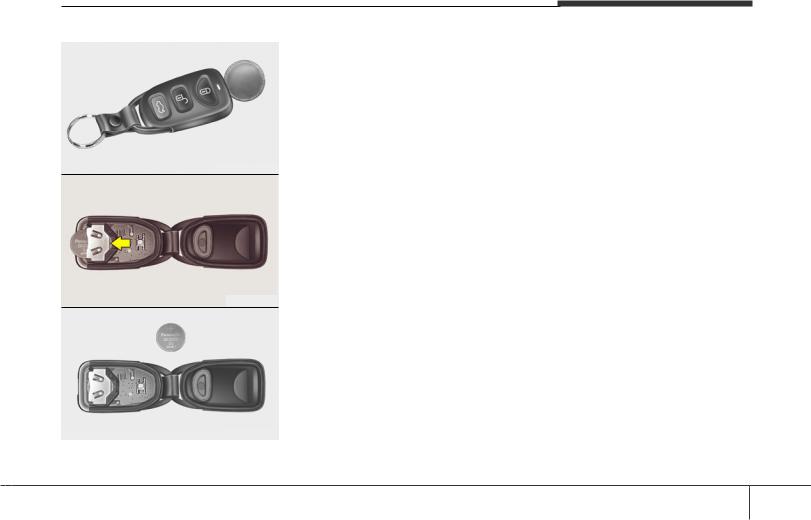
Knowing your vehicle
B070E01NF
HNF2005
HNF2006
Battery replacement
Transmitter uses a 3 volt lithium battery which will normally last for several years. When replacement is necessary, use the following procedure.
1.Insert a slim tool into the slot and gently pry open the transmitter center cover.
2.Replace the battery with new one. When replacing the battery, make sure the battery positive “+” symbol faces up as indicated in the illustration.
3.Install the battery in the reverse order of removal.
NOTICE
The keyless entry system transmitter is designed to give you years of troublefree use, however it can malfunction if exposed to moisture or static electricity. If you are unsure how to use your transmitter or replace the battery, contact an authorized Kia dealer.
For replacement transmitters, see an Authorized Kia Dealer for reprogramming.
NOTICE
•Using the wrong battery can cause the transmitter to malfunction. Be sure to use the correct battery.
•To avoid damaging the transmitter, don't drop it, get it wet, or expose it to heat or sunlight.
3 5

Knowing your vehicle
THEFT-ALARM SYSTEM (IF EQUIPPED)
Armed
stage
Disarmed |
|
|
|
Theft alarm |
stage |
|
|
|
stage |
|
|
|
|
|
Theft alarm system will not operate when the ignition key is in the ignition switch. If the lock button on the transmitter is pressed when the key is not in the ignition and any vehicle door or the trunk is open, then, the doors will lock but the theft alarm system will not activate. However, the theft alarm system will automatically activate when the open door(s) or trunk is closed and locked.
Armed stage
When the ignition switch is in the “LOCK” position, and key is not in the ignition, the system will be armed and the hazard lights will flash once when the following conditions are met:
•The hood, trunk and doors are all closed and locked with the transmitter or ignition key.
•If a door or the trunk is not opened within approximately 30 seconds after unlocking with the transmitter, all doors will be locked again and theft alarm system armed.
If the “Lock” button pressed for more than two times within 3 seconds, the horn will sounds from the second time pressed.
Do not arm the system until all passengers have left the vehicle. If the system is armed while a passenger(s) remains in the vehicle, the alarm may be activated when the remaining passenger(s) leaves the vehicle.
Theft alarm stage
The alarm will activate (horn will sound and lights flash) when:
•Any door is opened without using the transmitter or key.
•The trunk lid is opened without using the key.
•The engine hood is opened.
The alarm will sound ON for 27 seconds, then OFF for 10 seconds. This ON/OFF cycle will be repeated three times. During this time, the engine will not start.
The engine will not start while the theft-alarm system is armed or activated. You must disarm the theftalarm system to start the engine.
3 6

Knowing your vehicle
Opening the trunk with the alarm armed (if equipped)
When the alarm is armed, the alarm will not sound if the trunk lid is opened with the key.
However, if the trunk lid is not opened completely within two seconds after unlocking with the key, the alarm will sound.
Also, if any of the doors or hood is opened while the trunk lid is open and the alarm armed, the alarm will sound.
Disarmed stage
If the following conditions are met, the alarm system will be deactivated and the hazard flasher light will flash twice.
•When the doors are unlocked with the transmitter or ignition key.
After depressing unlock button, you must open the doors within 30 seconds or all doors will automatically lock again and the theft-alarm system will be armed.
•When the ignition switch is in the “ON” position.
The alarm will be deactivated when:
•The lock (  ), unlock (
), unlock ( ) button on the transmitter is pressed.
) button on the transmitter is pressed.
•The doors are unlocked with the ignition key.
•The ignition switch is in the “ON” position for 30 seconds or more.
NOTICE
Avoid trying to start the engine while the alarm is activated. The vehicle starting motor is disabled during the theftalarm stage.
3 7

Knowing your vehicle
IMMOBILIZER SYSTEM (IF EQUIPPED)
Your vehicle is equipped with an electronic engine immobilizer system to reduce the risk of unauthorized vehicle use.
Your immobilizer system is comprised of a small transponder in the ignition key, and antenna coil in the key cylinder and ICU (Immobilizer Control Unit) in the steering shaft.
With this system, whenever you insert your ignition key into the ignition switch and turn it to ON, the antenna coil in the ignition switch receives a signal from the transponder in the ignition key and then sends the signal to the ECU (Engine Control Unit).
The ECU checks the signal whether the ignition key is valid.
If the key is determined to be valid, the engine will start.
If the key is determined to be invalid, the engine will not start.
To deactivate the immobilizer system:
Insert the ignition key into the key cylinder and turn it to the ON position.
To activate the immobilizer system:
Turn the ignition key to the OFF position. The immobilizer system activates automatically. Without a valid ignition key for your vehicle, the engine will not start.
NOTICE
When starting the engine, do not use the key with other immobilizer keys around. Otherwise the engine may not start or may stop soon after it starts. Keep keys separate to avoid immobilizer malfunctions.
 CAUTION
CAUTION
Do not put metal accessories near the key or ignition switch.
The engine may not start for the metal accessories may interrupt the transponder signal from normally transmitting.
NOTICE
The transponder in your ignition key is an important part of the immobilizer system. It is designed to give years of troublefree service, however you should avoid exposure to moisture, static electricity and rough handling. Immobilizer system malfunction could occur.
NOTICE
Do not change, alter or adjust the immobilizer system because it could cause the immobilizer system to malfunction and should only be serviced by an authorized Kia dealer.
Malfunctions caused by improper alterations, adjustments or modifications to the immobilizer system are not covered by your vehicle manufacturer warranty.
3 8
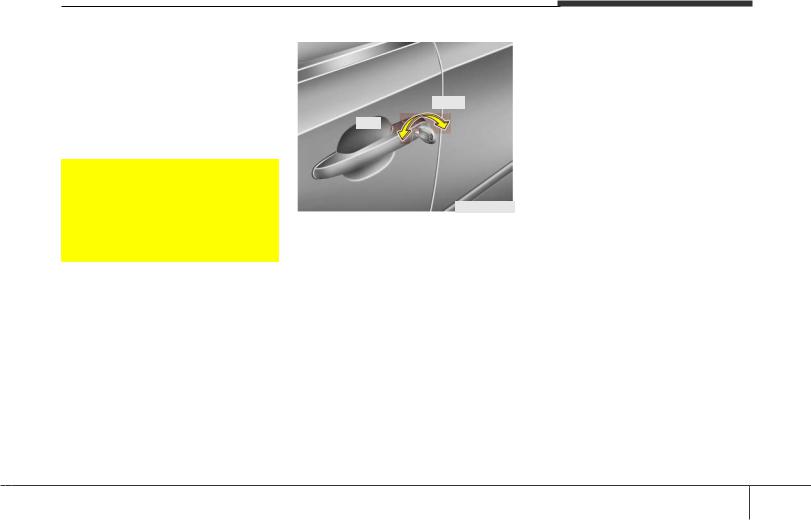
This device complies with Part 15 of the FCC rules. Operation is subject to the following two conditions:
1.This device may not cause harmful interference, and
2.This device must accept any interference received, including interference that may cause undesired operation.
 WARNING
WARNING
Changes or modifications not expressly approved by the party responsible for compliance could void the user's authority to operate the equipment.
DOOR LOCKS
Unlock
Lock
OMG035005
Operating door locks from outside the vehicle
•Turn the key toward rear of vehicle to unlock and toward front of vehicle to lock.
•If you lock the door with a key, all vehicle doors will lock automatically (if equipped).
•Turn the key to the right once to unlock the driver’s door and to the right twice within 4 seconds to unlock all doors. (if equipped)
Knowing your vehicle
•Doors can also be locked and unlocked with the transmitter (if equipped).
•Once the doors are unlocked, they may be opened by pulling the door handle.
•When closing the door, push the door firmly by hand. Make sure that doors are closed securely.
3 9
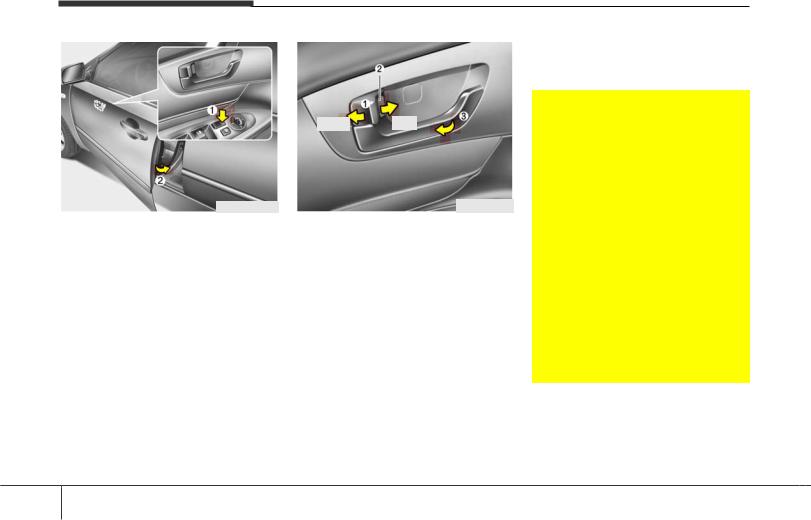
Knowing your vehicle
OMG035006A
To lock a door without the key, push the inside central door lock switch (1) to the “LOCK” position and close the door (2).
NOTICE
Always remove the ignition key, engage the parking brake, close all windows and lock all doors when leaving your vehicle unattended.
NOTICE
If the door is locked/unlocked multiple times in rapid succession with either the vehicle key or door lock switch, the system may stop operating temporarily in order to protect the circuit and prevent damage to system components.
Unlock Lock
OMG035007
Operating door locks from inside the vehicle
With the door lock button
•To unlock a door, push the door lock button forward to the “Unlock” position (red mark on button visible).
•To lock a door, push the door lock button (1) forward to the “Lock” position. If the door is locked properly, the red mark (2) on the door lock button will not be visible.
•To open a door, pull the door handle
(3) outward.
•If the inner door handle of front door is pulled when the door lock button is in lock position, the button is unlocked and door opens. (if equipped)
•Front doors cannot be locked if the ignition key is in the ignition switch and door is open.
 WARNING - Door lock malfunction
WARNING - Door lock malfunction
If a power door lock ever fails to function while you are in the vehicle, try one or more of the following techniques to exit:
•Operate the door unlock feature repeatedly (both electronic and manual) while simultaneously pulling on the door handle.
•Operate the other door locks and handles, front and rear.
•Lower a front window and use the key to unlock the door from outside.
•Lower the rear seats (if equipped), move to the cargo area and open the trunk using the emergency release handle (if equipped).
3 10

Driver’s door
OMG035008
Passenger’s door (if equipped)
OMG035009
With central door lock switch (if equipped)
•When pushing down on the front portion (1) of the switch, all vehicle doors will lock.
•When pushing down on the rear portion (2) of the switch, all vehicle doors will unlock.
•However, if the key is in the ignition switch and any front door is open, the doors will not lock when the front portion of central door lock switch is pressed.
 CAUTION - Doors
CAUTION - Doors
•The doors should always be fully closed and locked while the vehicle is in motion to prevent accidental opening of the door. Locked doors will also discourage potential intruders when the vehicle stops or slows.
•Be careful when opening doors and watch for vehicles, motorcycles, bicycles or pedestrians approaching the vehicle in the path of the door. Opening a door when something is approaching can cause damage or injury.
Knowing your vehicle
 WARNING - Unlocked vehicles
WARNING - Unlocked vehicles
Leaving your vehicle unlocked can invite theft or possible harm to you or others from someone hiding in your vehicle while you are gone. Always remove the ignition key, engage the parking brake, close all windows and lock all doors when leaving your vehicle unattended.
 WARNING - Unattended children
WARNING - Unattended children
An enclosed vehicle can become extremely hot, causing death or severe injury to unattended children or animals who cannot escape the vehicle. Furthermore, children might operate features of the vehicle that could injure them, or they could encounter other harm, possibly from someone gaining entry to the vehicle. Never leave children or animals unattended in your vehicle.
3 11
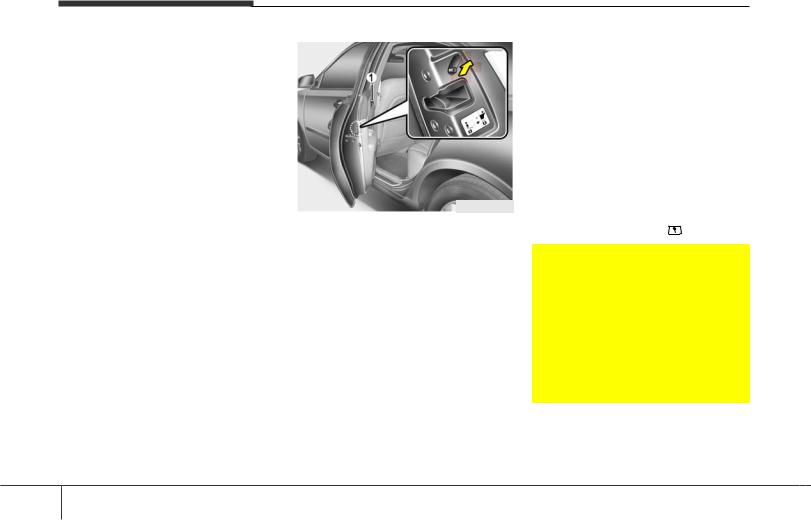
Knowing your vehicle
Impact sensing door unlock system (if equipped)
All doors will automatically unlock if a collision that warrants SRS air bag deployment is detected when the ignition switch is in the ON position.
However, if the impact causes damage to the vehicle electrical system or the mechanical door lock mechanisms, the impact sensing door unlock system may not operate.
OMG035010
Rear door child safety lock
The child safety lock is provided to help prevent children from accidentally opening the rear doors from inside the vehicle. The rear door safety locks should be used whenever children are in the vehicle.
1.Open the rear door.
2.Push the child safety lock located on the rear edge of the door to the “Lock”
position. When the child safety lock is in the “Lock (  )” position, rear door will not open when the inner door handle is pulled inside the vehicle.
)” position, rear door will not open when the inner door handle is pulled inside the vehicle.
3.Close the rear door.
4.To open the rear door, pull the outside door handle.
Even though the doors may be unlocked, the rear door will not open by pulling the inner door handle (1) until rear door child safety lock is unlocked (  ).
).
 WARNING - Rear door locks
WARNING - Rear door locks
If children accidentally open the rear doors while the vehicle is in motion, they could fall out and be severely injured or killed.To prevent children from opening the rear doors from the inside, the rear door safety locks should be used whenever children are in the vehicle.
3 12
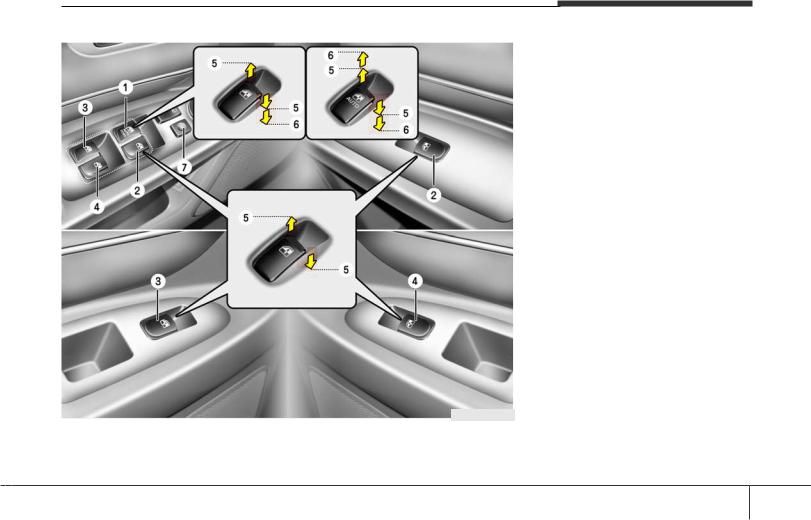
WINDOWS
• Type A |
• Type B |
OMG035011
Knowing your vehicle
Power windows (if equipped)
(1)Driver’s door power window switch
(2)Front passenger’s door power window switch
(3)Rear door (left) power window switch
(4)Rear door (right) power window switch
(5)Window opening and closing
(6)Automatic power window* (Driver’s window)
(7)Power window lock switch*
•Power window timer*
The power windows can be operated for approximately 30 seconds after the ignition key is removed or turned to the ACC or LOCK position. If the front door is open, the window will not operate unless the ignition key is in the ON position.
* : if equipped
3 13
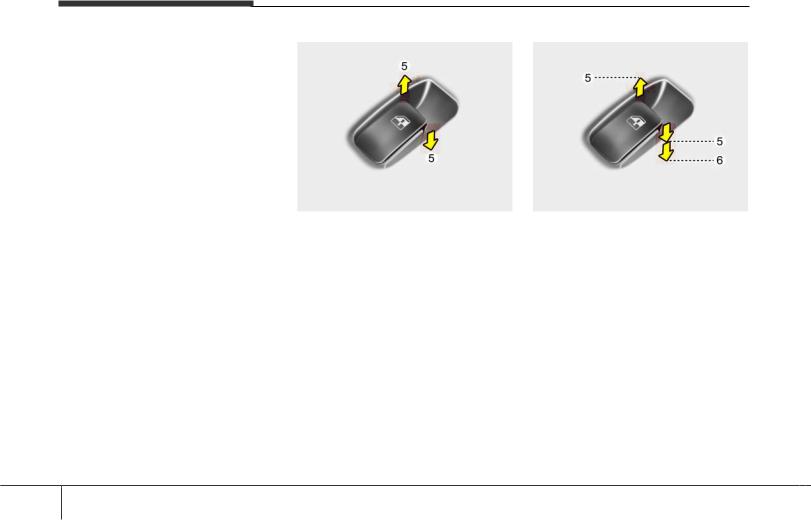
Knowing your vehicle
Power windows (if equipped)
The ignition switch must be in the ON position for power windows to operate. Each door has a power window switch that controls that door’s window. However, the driver has a power window lock switch which can block the operation of passenger windows.
If you notice buffeting and pulsation (wind shock) with either side window open, you should open the opposite window slightly to reduce the condition.
NOTICE
•To protect the power window system from the possibility of damage, do not open or close two windows at the same time. This will also ensure the longevity of the fuse.
•Never try to operate the main switch on the driver's door and the individual door window switch in opposing directions at the same time. If this is done, the window will stop and cannot be opened or closed.
OMG035012
Window opening and closing
The driver’s door has a master power window switch that controls all the windows in the vehicle. To open or close a window, press down (5) or pull up (5) the front portion of the corresponding switch.
OMG035013
Automatic power window (driver’s window, if equipped)
Type A - Automatic power window down
Depressing the power window switch momentarily to the second detent position (6) completely lowers the driver’s window even when the switch is released. To stop the window at the desired position while the window is in operation, pull up the switch momentarily to the opposite direction of the window movement.
3 14
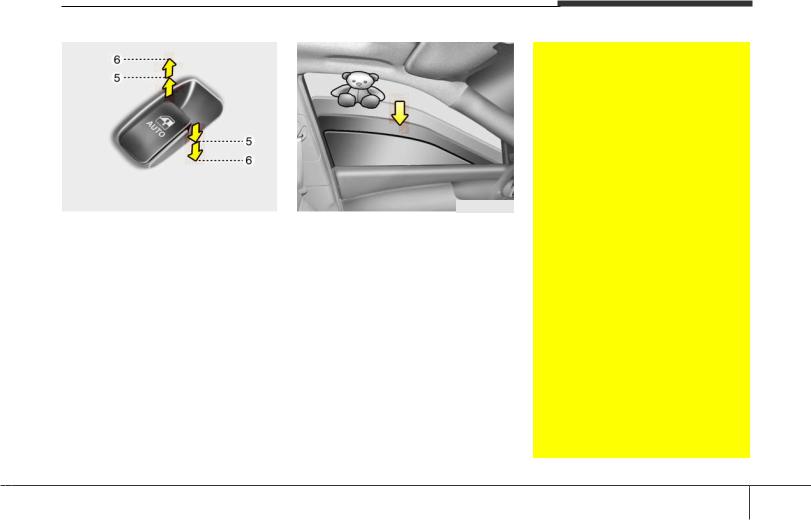
Knowing your vehicle
OMG035014
Type B - Automatic power window (if equipped)
Depressing or pulling up the power window switch momentarily to the second detent position (6) completely lowers or lifts the window even when the switch is released. To stop the window at the desired position while the window is in operation, pull up or depress the switch momentarily to the opposite direction of the window movement.
If the battery has been discharged or disconnected when the window operating, the automatic power window system must be reset as follows:
1.Turn the ignition key to ON position.
2.Close each window and continue pulling up on each power window switch for at least 1 second after the window is completely closed.
OMG035110
Automatic window reversal (When window is closed by the automatic power window)
If the upward movement of the window is blocked by an object or part of the body, the window will detect the resistance and will stop upward movement. The window will then lower approximately 8~12 inches (20~30 cm) to allow the object to be cleared.
 WARNING
WARNING
•The automatic window reversal feature (window lowers 8~12 inches (20~30 cm) when a resistance is detected) will only operate when the automatic power window operation feature is used. Automatic window reversal will not operate if the window is raised using the first detent position (5) on the power window switch or the window is raised using the second detent position
(6)on the switch within 2 seconds after the window is lowered by the automatic window reversal feature. Always double check to make sure all faces, arms, hands and other obstructions are safely out of the way of before operating the power window.
•If an object less than 0.15 inch (4 mm) in diameter is caught between the window glass and the upper window channel, the automatic reversal may not detect the resistance and will not operate. Therefore, always check for any obstructions before raising any window.
3 15
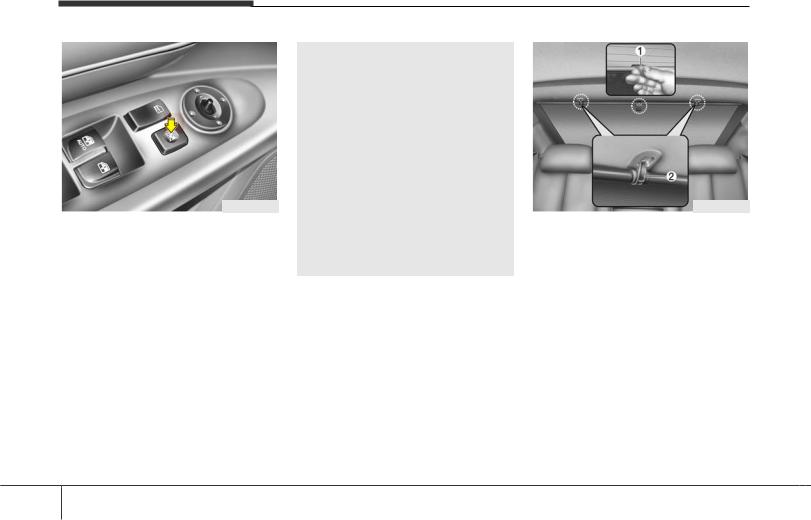
Knowing your vehicle
OMG035015
Power window lock switch (if equipped)
•The driver can disable the power window switches on all passenger doors by depressing the power window lock switch located on the driver’s door to LOCK (pressed).
•When the power window lock switch is ON, the driver’s master control cannot operate the passenger door power windows.
 CAUTION - Windows
CAUTION - Windows
•Always double-check to make sure all arms, hands, heads and other obstructions are safely out of the way before closing a window. Serious injury could occur.
•Do not allow children to play with the power windows. Keep the driver’s door power window lock switch in the LOCK position (depressed). Serious injury can result from unintentional window operation by a child.
•Never extend face or arms outside through the window opening while driving.
OMG035016
Curtain (if equipped)
Use the rear curtain installed in the rear package shelf to shield the rear seat from direct sunlight through the rear window.
Grasp the tab on the end (1) of the curtain and carefully pull it up to hook (2).
3 16
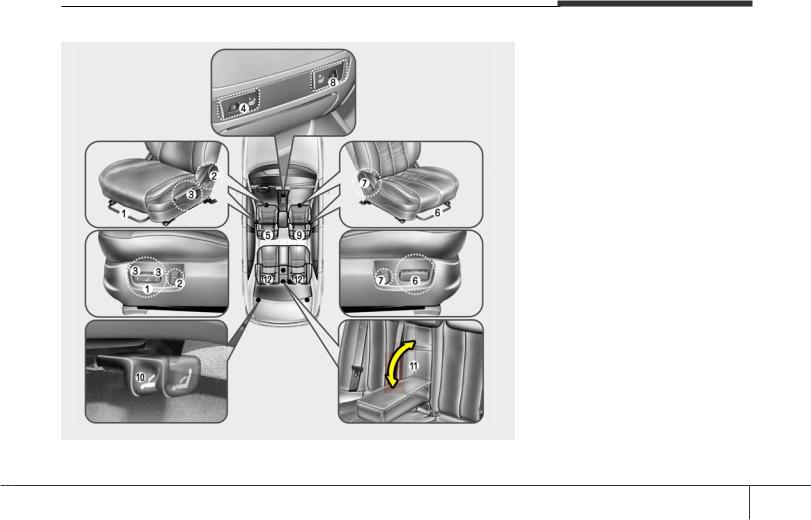
SEAT
Manual Type |
|
Manual Type |
|
|
Electric type |
Electric type |
||
|
|
|
Knowing your vehicle
Driver’s seat
(1)Forward / backward
(2)Seatback recliner
(3)Seat cushion, height*
(4)Seat warmer*
(5)Headrest
Front passenger seat
(6)Forward / backward
(7)Seatback recliner
(8)Seat warmer*
(9)Headrest
Rear seat
(10)Split folding rear seat*
(11)Armrest*
(12)Headrest
* ; if equipped
OMG035017
3 17
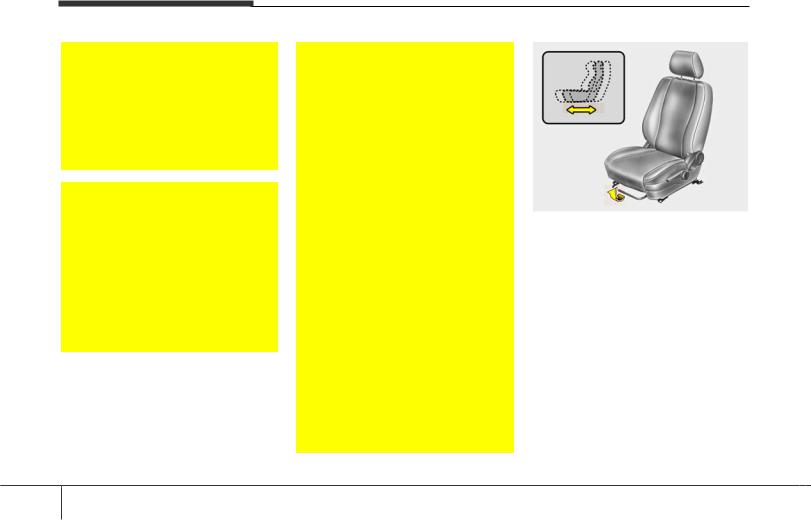
Knowing your vehicle
 WARNING - Loose objects
WARNING - Loose objects
Loose objects in the driver’s foot area could interfere with the operation of the foot pedals, possibly causing an accident. Loose objects might interfere with the seat slide mechanism. Do not place anything under the front seats.
 WARNING - Seating position
WARNING - Seating position
In order to avoid unnecessary air bag injuries including the possibility of severe injury or death, always sit as far back as possible by moving the seat far back, while still maintaining good vehicle control. Serious injury or death may be caused due to the deployment of the passenger’s air bag.
 WARNING - Driver’s seat
WARNING - Driver’s seat
•Never attempt to adjust seat while the vehicle is moving. This could result in loss of control, and an accident causing death, serious injury, or property damage.
•Do not allow anything to interfere with the normal position of the seatback. Storing items against a seatback or in any other way interfering with proper locking of a seatback could result in serious or fatal injury in a sudden stop or collision.
•Always drive and ride with your seatback upright lap portion of the safety belt is snug and low across the hips. This puts your safety belts in the best position to protect you in case of an accident.
•In order to avoid unnecessary air bag injuries including the possibility of severe injury or death, always sit as far back as possible from the steering wheel so that your chest is at least 10 inches (250 mm) away from the steering wheel.
OMG035018
Front seat adjustment (Manual type)
Adjusting the seat forward and backward
To move the seat forward or backward:
1.Pull the seat slide adjustment lever under the front edge of the seat cushion up and hold it.
2.Slide the seat to the desired position.
3.Release the lever and make sure the seat is locked in place.
Adjust the seat before driving, and make sure the seat is locked securely by trying to move forward and backward without using the control knob. If the seat moves, it is not locked properly.
3 18
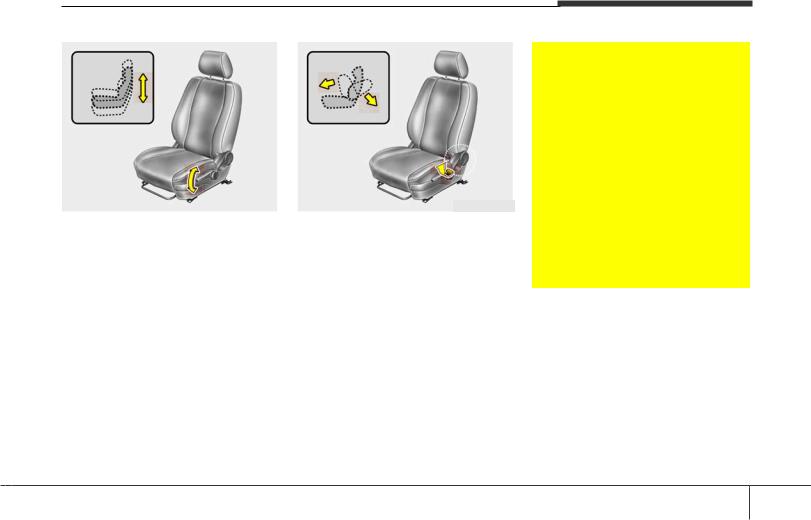
Knowing your vehicle
OMG035019
Adjusting height of the driver’s seat cushion (if equipped)
To change the height of the seat cushion:
•Pivot the lever upward to raise the seat cushion.
•Pivot the lever downward to lower the seat cushion.
OMG035020
Adjusting the seatback recliner
To recline the seatback:
1.Lean forward slightly and lift up on the seatback recline lever located on the outside of the seat, at the rear.
2.Carefully lean back on the seat and adjust the seatback to the desired position.
3.Release the lever and make sure the seatback is locked in place. (The lever MUST return to its original position for the seatback to lock.)
 WARNING - Driver responsibility for front seat passenger
WARNING - Driver responsibility for front seat passenger
Driving or riding in a vehicle with a front seatback reclined could lead to serious or fatal injury in an accident. If a front seat is reclined during an accident, the occupant’s hips may slide under the lap portion of the safety belt applying great force to the unprotected abdomen or neck. Serious or fatal internal injuries could result. The driver must advise the front passenger to keep the seatbacks in comfortably upright position whenever the vehicle is in motion.
3 19
